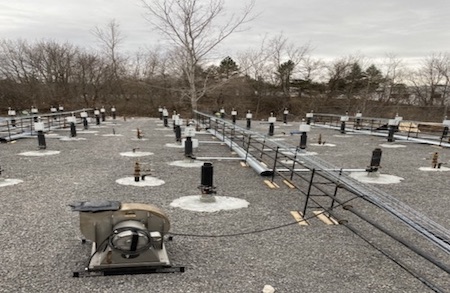Holley will allow trailers of compressed natural gas at former Diaz size
Natural gas needed to heat up soil as part of $20 million cleanup

Photo by Tom Rivers: David Macone, a lead thermal technician for AECOM, speaks during a public hearing on Monday about the company’s need for trailers of compressed natural gas as part of the cleanup at the former Diaz Chemical site at 40 Jackson St. Mylynda Kubo, the village code enforcement officer, is at left.
HOLLEY – The Village of Holley Planning Board approved the site plan to allow two trailers of compressed natural gas at the former Diaz Chemical site at 40 Jackson St.
The AECOM environmental services company, a contractor hired by the federal Environmental Protection Agency, said the trailers with natural gas are needed as a backup heating source as part of the cleanup at the site.
If used at capacity the trailers would need to be replaced every 3 ½ days, said David Macone, a lead thermal technician for AECOM.
The trailers would be kept in a fenced in area that would be locked. There would be an automatic shut-off if the heat gets too high or if there is a malfunction.
The natural gas is needed to heat up soil to 100 degrees Celsius (212 degrees Fahrenheit). AECOM will use piped-in natural gas for the project. The trailers are a backup if more gas is needed especially during very cold weather, Macone said.

Provided photo: Many heater wells have been constructed as part of the thermal treatment project in Holley.
Planning Board Chairwoman Sandy Heise highlighted a letter from Justin Neiderhofer, the Orleans County deputy emergency management director. He said he supports the project with the natural gas trailers because it will ensure the project moves along without disruption. Having the trailers on site doesn’t pose a significantly greater risk, he said.
The biggest risk is when the trailers are swapped out. Niederhofer said the trailers come with several safety features to reduce the risks.
“The alternative option would be to not allow them to bring in the trucks, and have this ground decontamination process take up to a year longer, extending the length of the overall risk to the community,” Niederhofer wrote in a July 7 letter.
Murray Joint Fire District Chief Harris Reed attended Monday’s public hearing about the trailers of natural gas at the property. Reed said he favors the plan because it will speed up removal of contaminants from the soil.
However, he asked that AECOM pay to have 30 volunteer firefighters be trained in responding to an emergency at the site. Reed would like a group of firefighters from Murray, Clarendon, Kendall and Brockport be trained at the state academy in Moutour Falls. He said the cost would be about $3,000.
Macone said he couldn’t give official approval for that request on Monday without checking with the company, but he expected AECOM would approve the funding.
The EPA has hired AECOM for the second and final phase of a thermal treatment of contaminated soil and groundwater at the Diaz Chemical Superfund site in Holley.
The system is being used to treat the remainder of the on-site contamination. EPA started constructing the system in May 2020, using samples and other information obtained during the first phase of treatment that used a smaller-scale version of the system.
EPA treated about 10% of the contaminated soil and groundwater at the site under that first phase, which was completed in October 2018.
The thermal cleanup is a $20 million project. That doesn’t include the $12.5 million the EPA has already spent on the cleanup, using money from the Superfund. The EPA removed buildings, pipes, drums and tanks. Only two warehouses remain from Diaz, which declared bankruptcy and abandoned the site in 2002. The company operated for about 30 years in Holley.
The final phase of treatment targets 1.5 acres of the site and will be performed in two stages. The thermal treatment system is projected to operate for up to four years to clean up the site.
Thermal treatment system
The thermal treatment system uses heat to turn the contaminants in the soil and groundwater into vapors. The vapors will then be captured by extraction wells and treated by a combination of compression, cooling, condensation and granular activated carbon. The system will operate 24 hours a day, seven days a week.
In addition, EPA will excavate soil from two areas. The excavated soil will be consolidated, thermally treated, and disposed of off-site, the EPA said in a previous news release. The excavated areas will be backfilled with clean soil. EPA will monitor the air around the perimeter, monitor noise, and follow a traffic control plan to minimize disruptions to the neighborhood.
After the second phase of operations is completed, EPA will remove the treatment equipment and restore the property. This will include regrading the site to ensure it has proper drainage and revegetation so as to prevent erosion.



































































